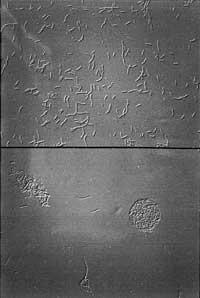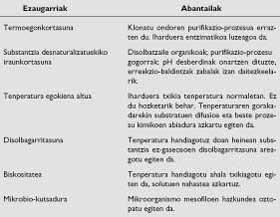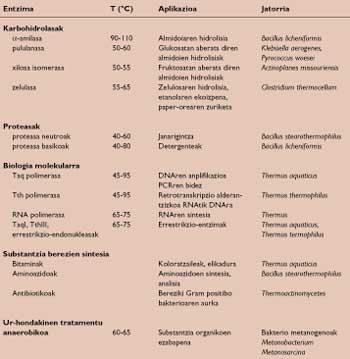Thermophilic microorganisms
1994/11/01 Lasa Uzkudun, Iñigo Iturria: Elhuyar aldizkaria
Most of the organisms studied in depth are adapted to moderate temperatures (15-40ºC) and also lose the ability to live outside these narrow temperature limits. They are the majority of eukaryotic group organisms (except for some singular exceptions) and are called “mesophils”.

High temperature natural areas exist in the soil. These have selected prokaryotic organisms that need a high temperature to live in this environment. Within high temperature we can distinguish moderate thermophilic microorganisms (45-50ºC), extreme thermophiles (65-90ºC) and hyperthermophiles (those that need to survive 90ºC). For unknown reasons, the group of hyperthermophilic bacteria consists only of Archeobacteria. In the group of extreme thermophiles, in addition to Archeobacteria, there are also Eubacteria.
When thermophilic microorganisms were discovered, the question arises: Where is the limit with the temperature of life? Thomas Brock, discoverer of thermophilic microorganisms, claimed that as cells of aqueous chemical systems, life would be limited to environments in which water is kept in liquid state. However, submarines have been found habitats of 250 ° C, lifeless, questioning the previous hypothesis. Currently there are no signs of life above 110°C, and since biological molecules above 150-160°C are not stable, it can be thought that the limits of life will not be greater than those found.
Are there physiological or biochemical reasons for developing these microorganisms at such high temperatures? Or in other words, what is the thermostability of thermophilic microorganisms based on? Initially it was thought that the microorganism membrane could isolate, performing all its metabolic functions at a temperature similar to that of mesophilous microorganisms. This theory was immediately discarded by the fact that all enzymatic systems of microorganisms can function at a temperature similar to that developed. Subsequently it was thought that in the cytoplasm there were substances to thermostabilize the cellular components. Currently it is known that in the cytoplasm of thermophilic microorganisms there are numerous thermostabilizers (polyamine, ends, spermidine, spermine), but the reason for the thermostability lies in the nature of each cellular component.
Industrial applications of thermoset enzymes
Biotechnologically, the most important characteristic of thermophilic microorganisms is the formation of enzymes that catalyze biochemical reactions at much higher temperatures than mesophilous microorganisms. Some of the industrial advantages of using thermoset enzymes are summarized in Table 1.
However, there are processes in which the lack of stability of a substrate prevents its use. This problem is common in the pharmaceutical industry because most reaction components are thermosensitive. The main inadequacies in the use of thermoset enzymes are shown in Table 2.
Despite the advantages of thermophilia, they are currently understudied. Therefore, in many industrial processes, because alternative thermophilic enzymes are not known, mesophilic enzymes are used. However, the use of thermoset enzymes in some processes is essential. Some examples are presented in Table 3.
Thermus aquaticus, polymerase DNA polymerase (Taq polymerase) from the thermophilic microorganism, has made possible the development of the technique called PCR (Polimerase Chain Reaction). Since the importance of this technique in the field of molecular biology is fundamental, it is not surprising that in 1993 he awarded the Nobel Prize in Medicine to its creator Kary Mulliser. As this technique has been created, as more thermophilic microorganisms are known, new applications will be created.




Gai honi buruzko eduki gehiago
Elhuyarrek garatutako teknologia





